This document provides a comprehensive introduction to structures in C programming, explaining their definition, declaration, and usage, including nested structures, arrays of structures, and pointers to structures. It covers how to initialize and access structure members, copy and compare structures, and pass structures to functions. Additionally, it illustrates concepts with examples and syntax to enhance understanding of handling complex data types in C.
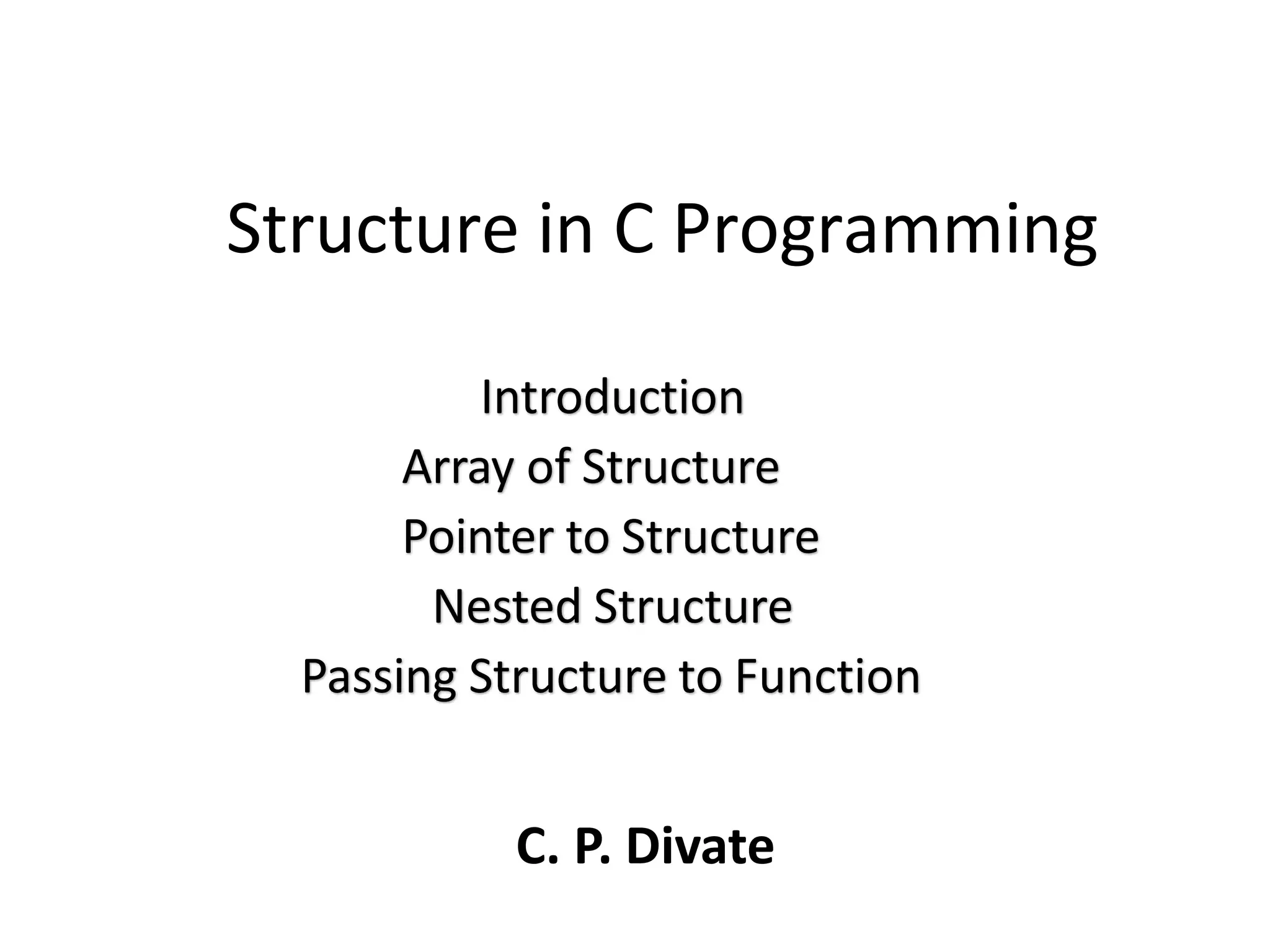
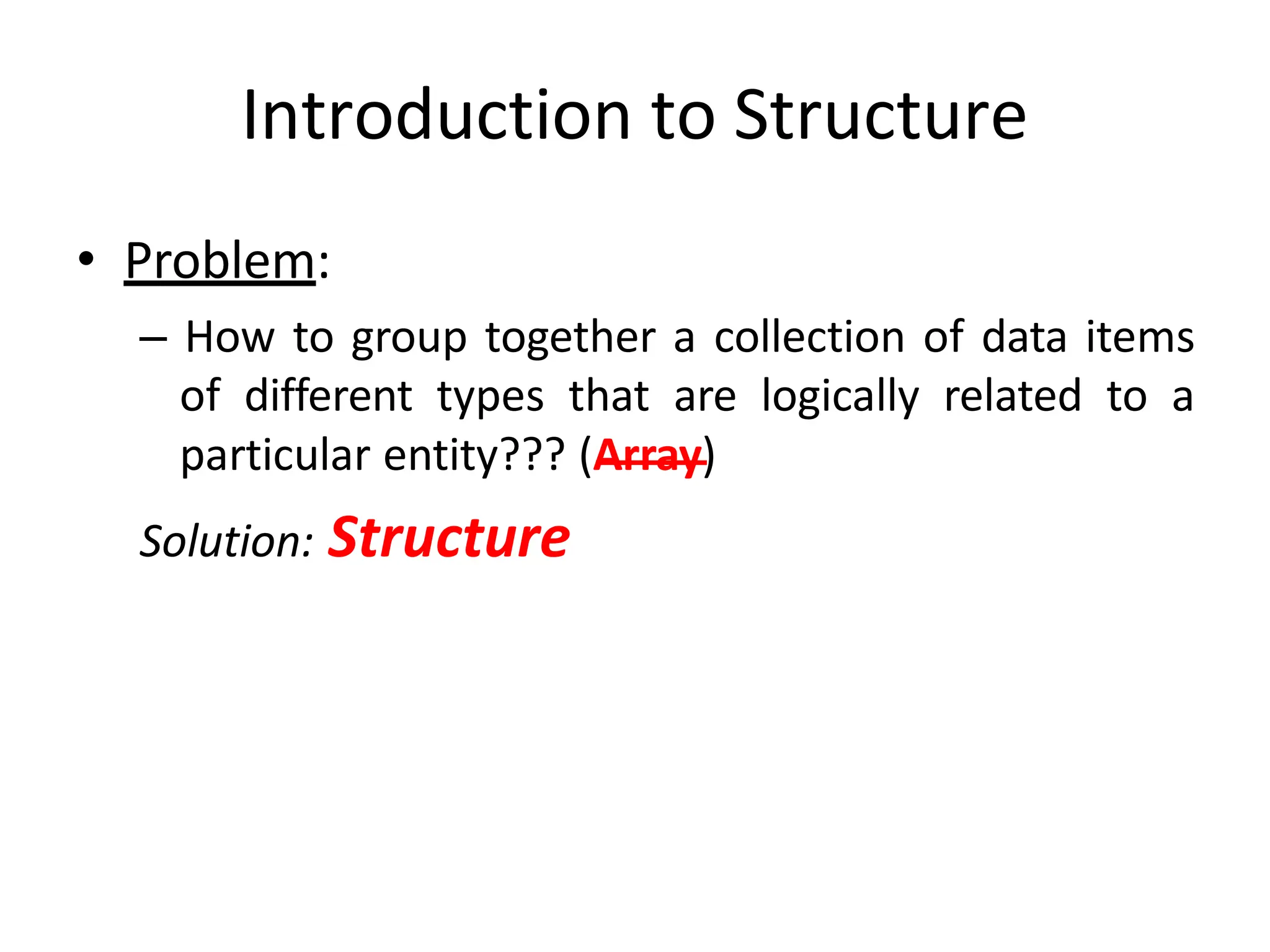
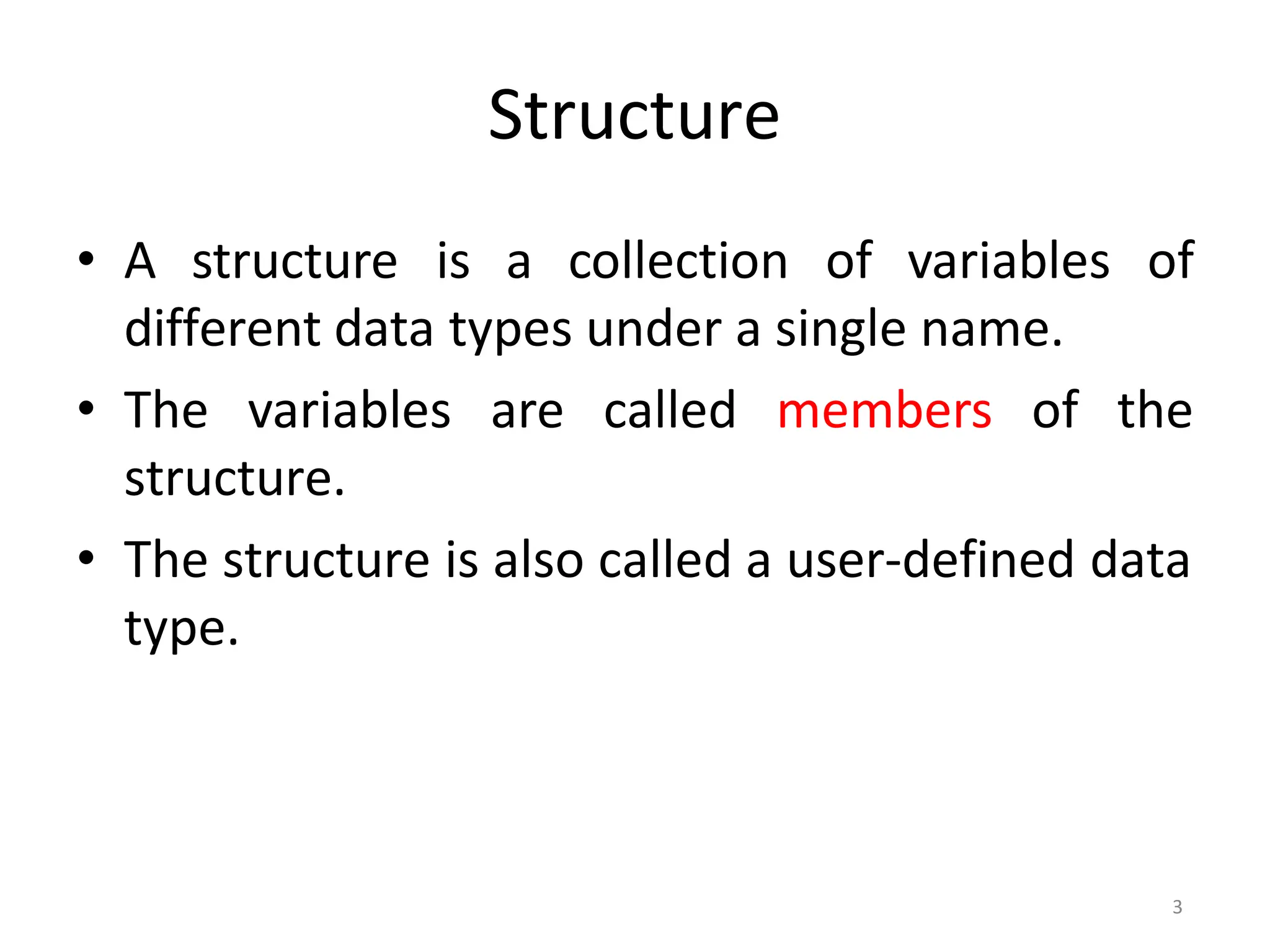
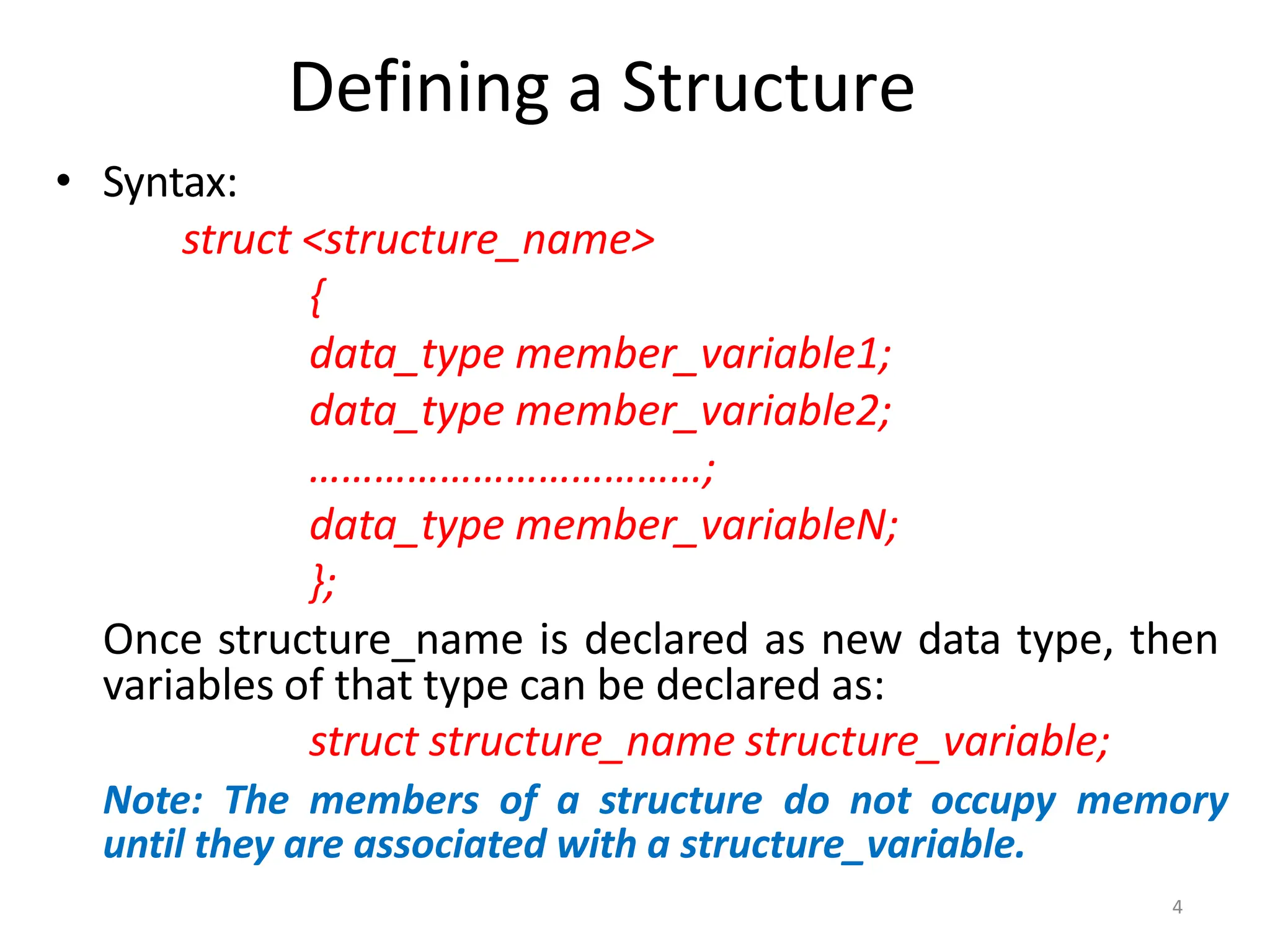
![5
• Example
struct student
{
char name[20];
int roll_no;
float marks;
char gender;
long int phone_no;
};
struct student st;
• Multiple variables of struct student type can be declared
as:
struct student st1, st2, st3;](https://image.slidesharecdn.com/structureincprogram-240510123220-b6219d62/75/Fundamentals-of-Structure-in-C-Programming-5-2048.jpg)
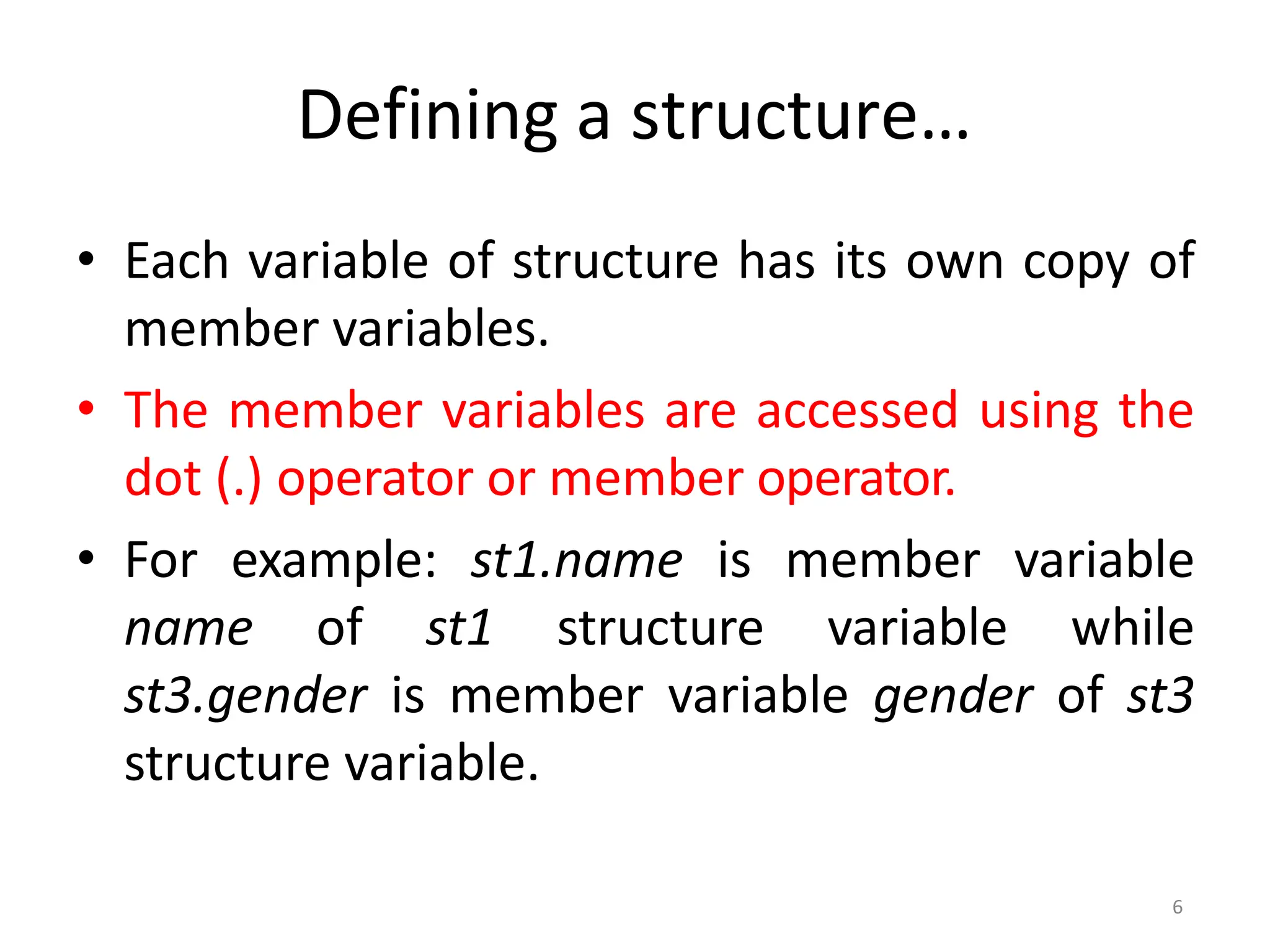
![Defining a structure…
• The structure definition
variable declaration can
combined as:
struct student
{
char name[20];
int roll_no;
float marks;
char gender;
long int phone_no;
}st1, st2, st3;
The use of structure_name is
and
be optional.
struct
{
char name[20];
int roll_no;
float marks;
char gender;
long int phone_no;
}st1, st2, st3;
7](https://image.slidesharecdn.com/structureincprogram-240510123220-b6219d62/75/Fundamentals-of-Structure-in-C-Programming-7-2048.jpg)
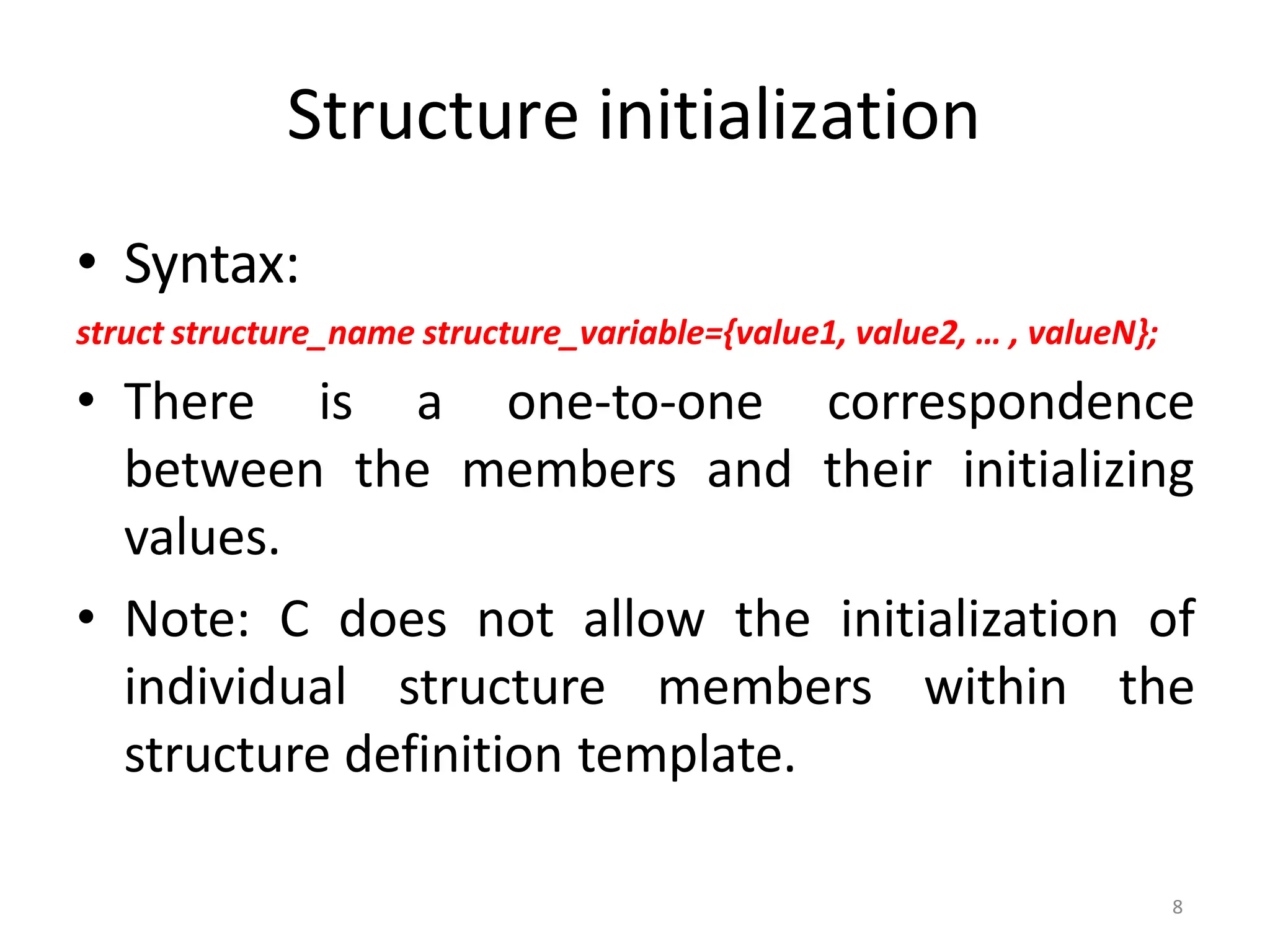
![struct student
{
char name[20];
int roll_no;
float marks;
char gender;
long int phone_no;
};
void main()
{
struct student st1={“ABC", 4, 79.5, 'M', 5010670};
clrscr();
printf("NametttRoll No.tMarksttGendertPhone No.");
printf("n.........................................................................n");
printf("n %stt %dtt %ft %ct %ld", st1.name, st1.roll_no, st1.marks,
st1.gender, st1.phone_no);
getch();
}
9](https://image.slidesharecdn.com/structureincprogram-240510123220-b6219d62/75/Fundamentals-of-Structure-in-C-Programming-9-2048.jpg)
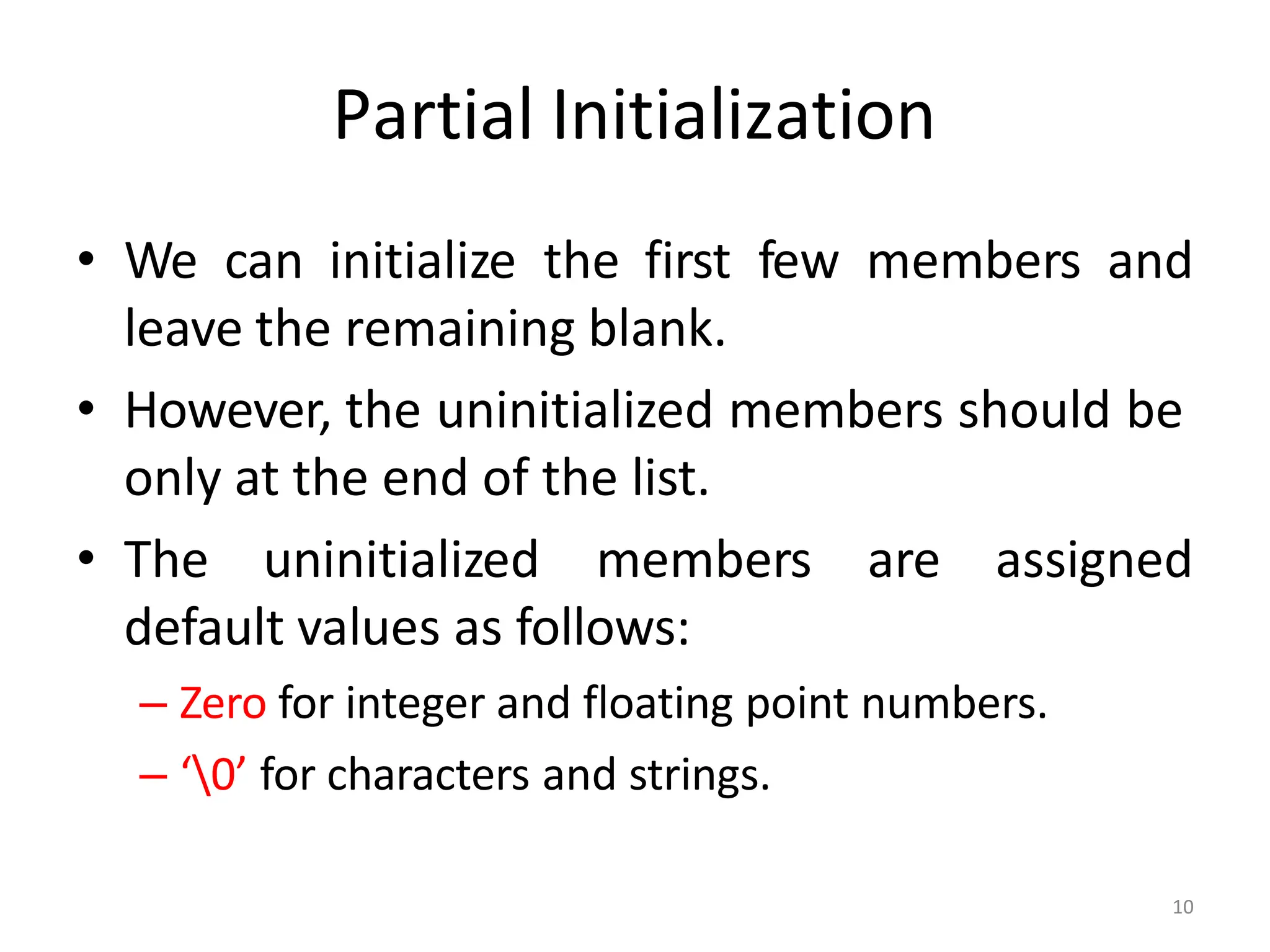
![11
struct student
{
char name[20];
int roll;
char remarks;
float marks;
};
void main()
{
struct student s1={“name", 4};
clrscr();
printf("Name=%s", s1.name);
printf("n Roll=%d", s1.roll);
printf("n Remarks=%c", s1.remarks);
printf("n Marks=%f", s1.marks);
getch();
}](https://image.slidesharecdn.com/structureincprogram-240510123220-b6219d62/75/Fundamentals-of-Structure-in-C-Programming-11-2048.jpg)
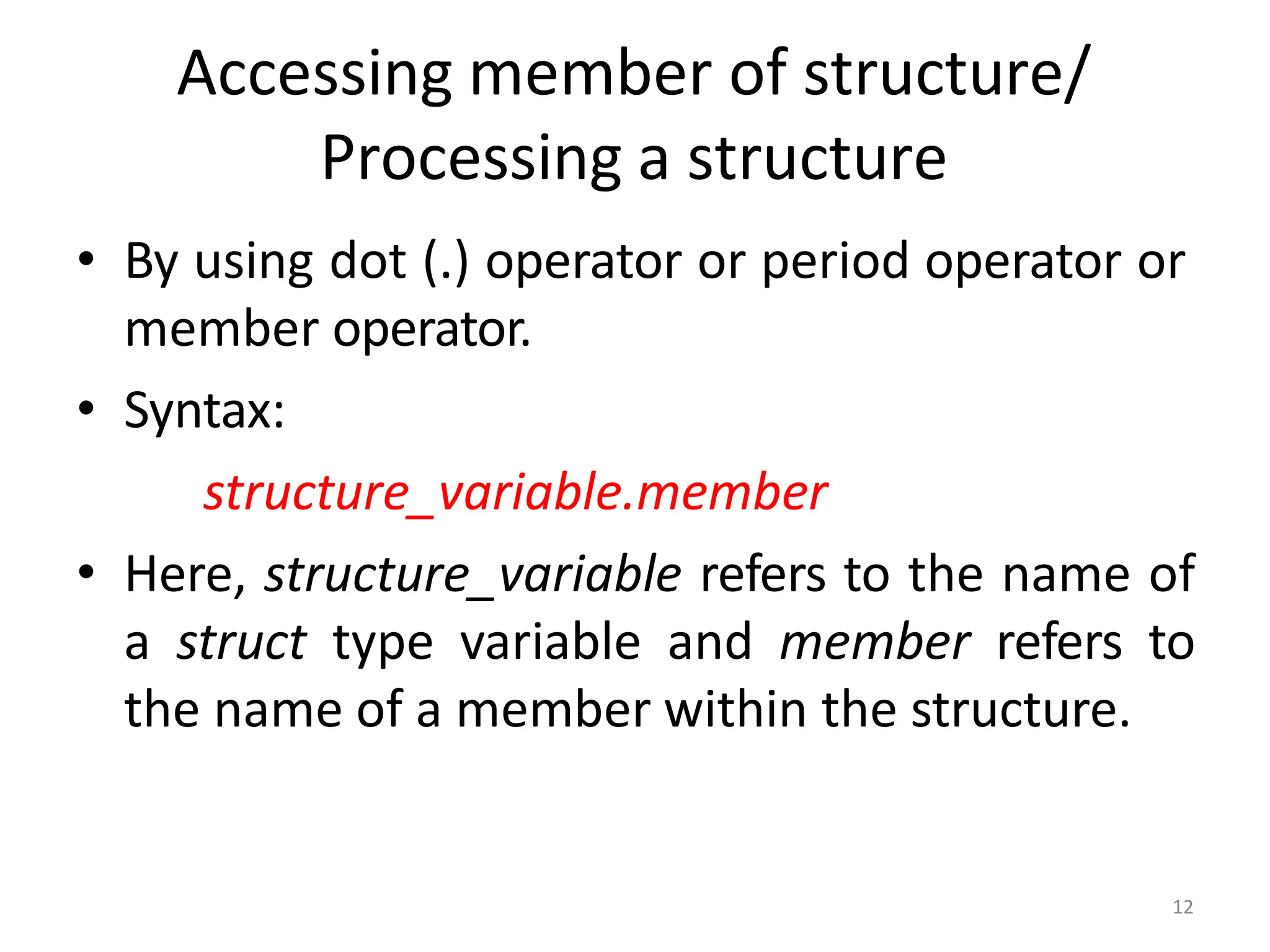

![14
struct student
{
char name[20];
int roll;
float mark;
};
void main()
{
struct student s;
clrscr();
printf("Enter name:t");
gets(s.name);
printf("n Enter roll:t");
scanf("%d", &s.roll);
printf("n Enter marks:t");
scanf("%f", &s.mark);
printf("n Name t Roll t Markn");
printf("n...................................n");
printf("n%st%dt%f", s.name, s.roll, s.mark);
getch();
}](https://image.slidesharecdn.com/structureincprogram-240510123220-b6219d62/75/Fundamentals-of-Structure-in-C-Programming-14-2048.jpg)
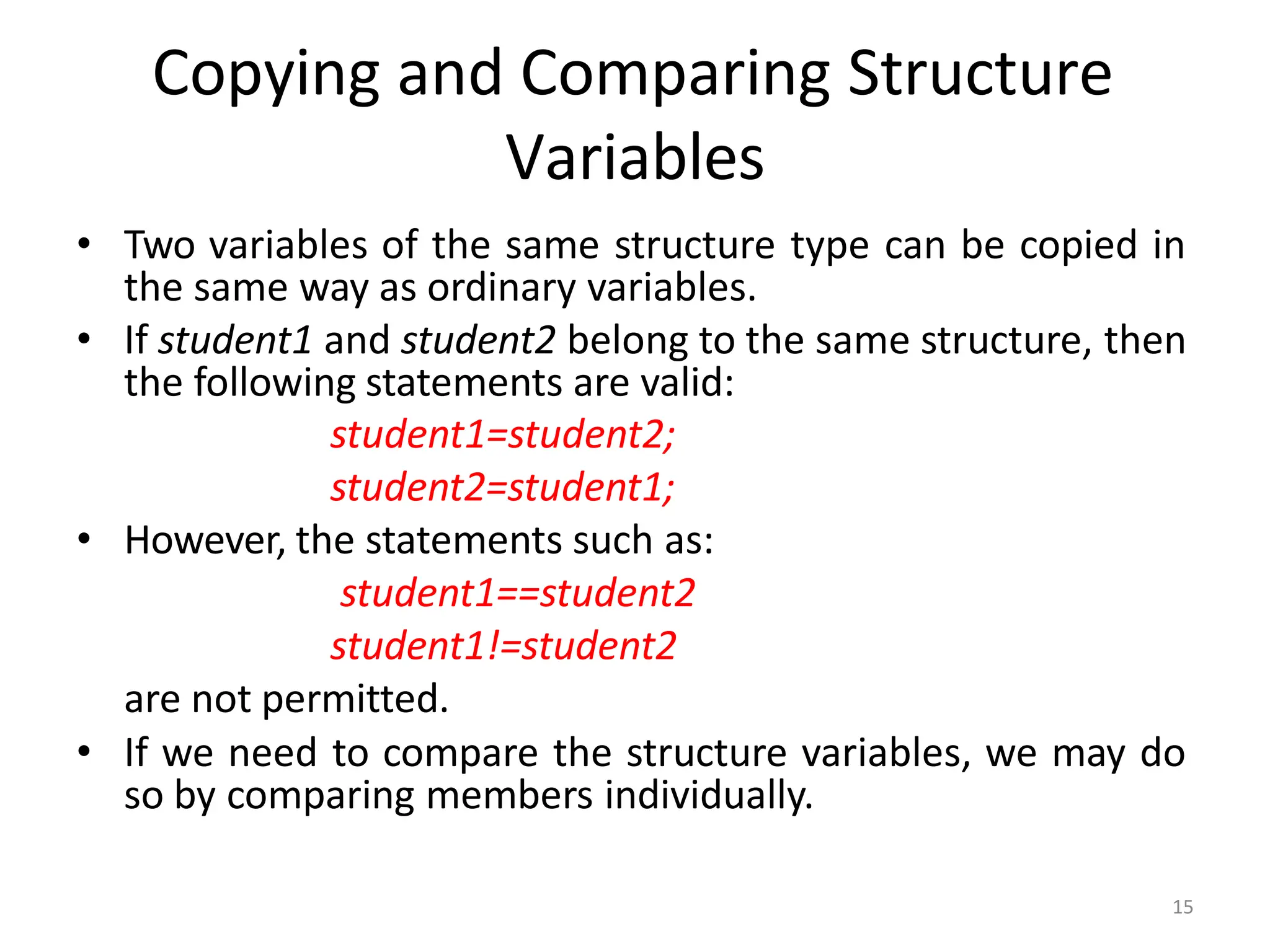
![struct student
{
char name[20];
int roll;
};
void main()
{
struct student student1={“ABC", 4, };
struct student student2;
clrscr();
student2=student1;
printf("nStudent2.name=%s", student2.name);
printf("nStudent2.roll=%d", student2.roll);
if(strcmp(student1.name,student2.name)==0 &&
(student1.roll==student2.roll))
{
printf("nn student1 and student2 are same.");
}
getch();
} 16
Here, structure has been declared
global i.e. outside of main()
function. Now, any function can
access it and create a structure
variable.](https://image.slidesharecdn.com/structureincprogram-240510123220-b6219d62/75/Fundamentals-of-Structure-in-C-Programming-16-2048.jpg)
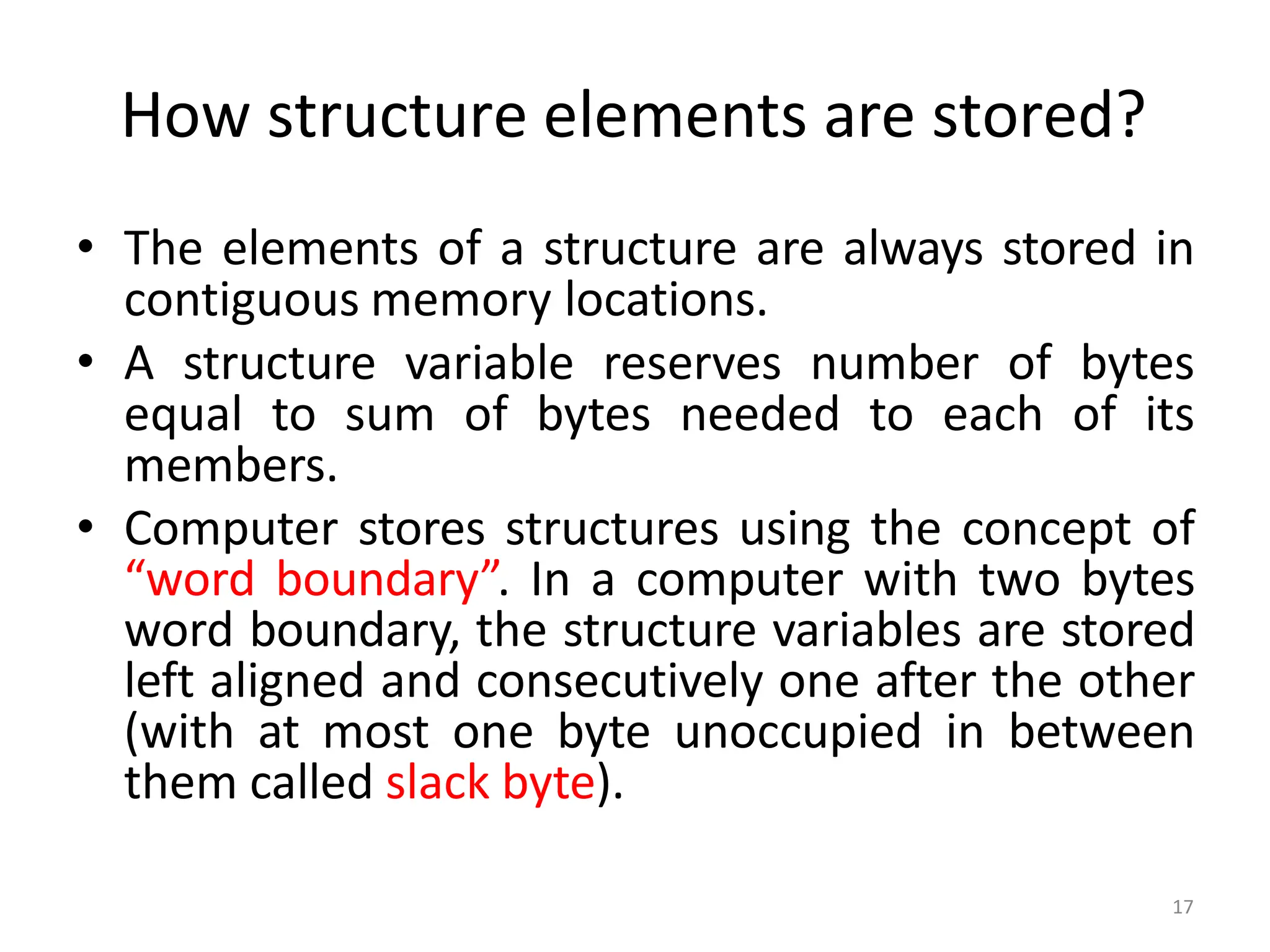

![19
Array of structure
• Let us consider we have a structure as:
struct student
{
char name[20];
int roll;
char remarks;
float marks;
};
• If we want to keep record of 100 students, we have to make 100
structure variables like st1, st2, …,st100.
• In this situation we can use array of structure to store the records of
100 students which is easier and efficient to handle (because loops
can be used).](https://image.slidesharecdn.com/structureincprogram-240510123220-b6219d62/75/Fundamentals-of-Structure-in-C-Programming-19-2048.jpg)
![Array of structure…
• Two ways to declare an
array of structure:
struct student
{
char name[20];
int roll;
char remarks;
float marks;
}st[100];
struct student
{
char name[20];
int roll;
char remarks;
float marks;
};
struct student st[100];
20](https://image.slidesharecdn.com/structureincprogram-240510123220-b6219d62/75/Fundamentals-of-Structure-in-C-Programming-20-2048.jpg)
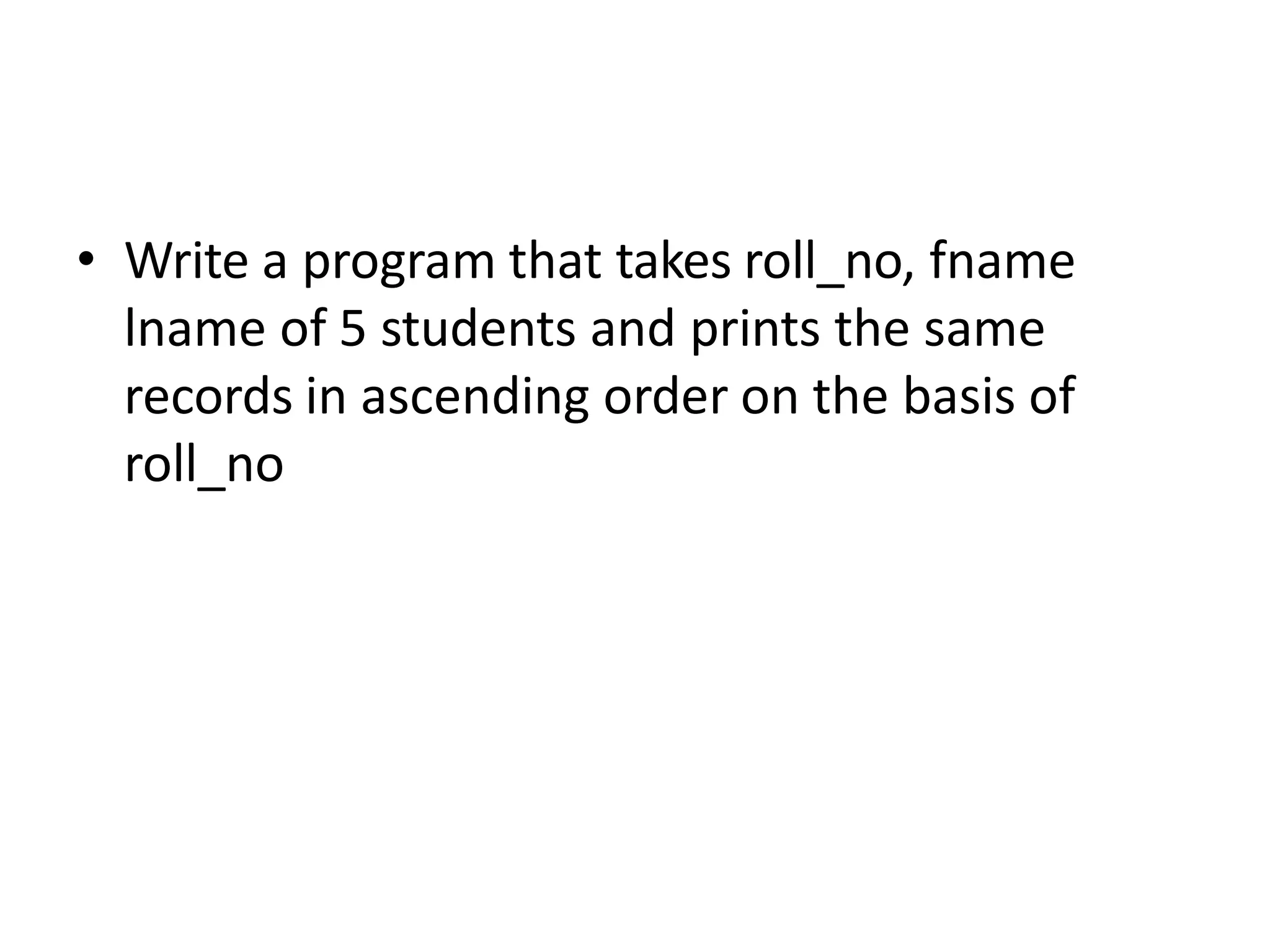
![Reading values
for(i=0; i<5; i++)
{
printf("n Enter roll number:");
scanf("%d", &s[i].roll_no);
printf("n Enter first name:");
scanf("%s", &s[i].f_name);
printf("n Enter Last name:");
scanf("%s", &s[i].l_name);
}](https://image.slidesharecdn.com/structureincprogram-240510123220-b6219d62/75/Fundamentals-of-Structure-in-C-Programming-22-2048.jpg)
![Sorting values
for(i=0; i<5; i++)
{
for(j=i+1; j<5; j++)
{
if(s[i].roll_no<s[j].roll_no)
{
temp = s[i].roll_no;
s[i].roll_no=s[j].roll_no;
s[j].roll_no=temp;
}
}
}](https://image.slidesharecdn.com/structureincprogram-240510123220-b6219d62/75/Fundamentals-of-Structure-in-C-Programming-23-2048.jpg)
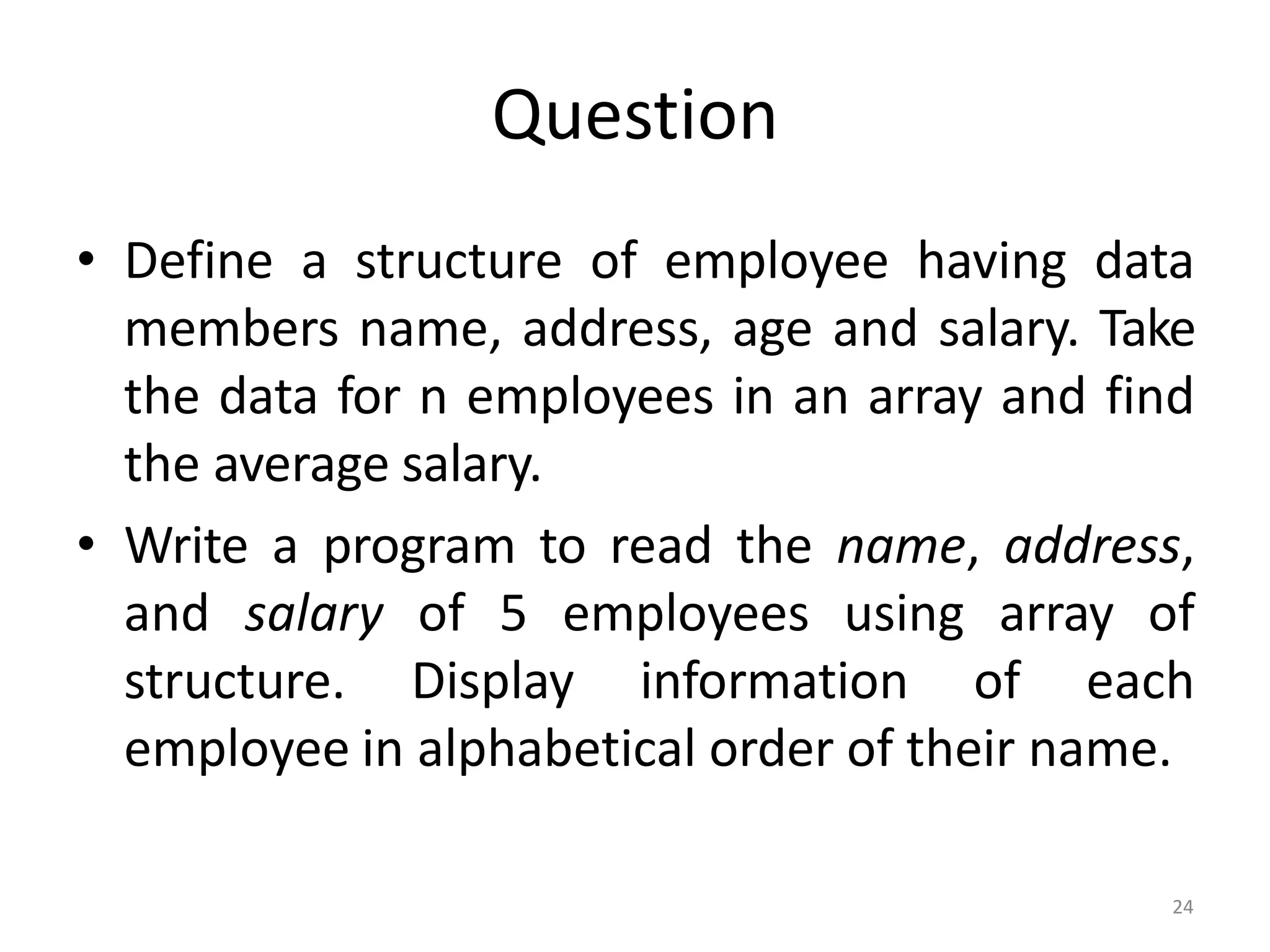
![25
Array within Structure
• We can use single or multi dimensional arrays of
type int or float.
• E.g. struct student
{
char name[20];
int roll;
float marks[6];
};
struct student s[100];](https://image.slidesharecdn.com/structureincprogram-240510123220-b6219d62/75/Fundamentals-of-Structure-in-C-Programming-25-2048.jpg)
![26
Array within structure…
• Here, the member marks contains six
elements, marks[0], marks[1], …, marks[5]
indicating marks obtained in six different
subjects.
• These elements can be accessed using
appropriate subscripts.
• For example, s[25].marks[3] refers to the
marks obtained in the fourth subject by the
26th student.](https://image.slidesharecdn.com/structureincprogram-240510123220-b6219d62/75/Fundamentals-of-Structure-in-C-Programming-26-2048.jpg)
![for(i=0;i<n;i++)
{
printf("n Enter information about student%d",i+1);
printf("n Name:t");
scanf(" %s", s[i].name);
printf("n Class:t");
scanf("%d", &s[i]._class);
printf("n Section:");
scanf(" %c", &s[i].section);
printf("n Input marks of 6 subjects:t");
for(j=0;j<6;j++)
{
scanf("%f", &temp);
s[i].marks[j]=temp;
}
} 27
Reading Values](https://image.slidesharecdn.com/structureincprogram-240510123220-b6219d62/75/Fundamentals-of-Structure-in-C-Programming-27-2048.jpg)
![28
Structure within another Structure
(Nested Structure)
• Let us consider a structure personal_record to
store the information of a person as:
• struct personal_record
{
char name[20];
int day_of_birth;
int month_of_birth;
int year_of_birth;
float salary;
}person;](https://image.slidesharecdn.com/structureincprogram-240510123220-b6219d62/75/Fundamentals-of-Structure-in-C-Programming-28-2048.jpg)
![29
Structure within another Structure
(Nested Structure)…
• In the structure above, we can group all the items related to birthday
together and declare them under a substructure as:
struct Date
{
int day_of_birth;
int month_of_birth;
int year_of_birth;
};
struct personal_record
{
char name[20];
struct Date birthday;
float salary;
}person;](https://image.slidesharecdn.com/structureincprogram-240510123220-b6219d62/75/Fundamentals-of-Structure-in-C-Programming-29-2048.jpg)
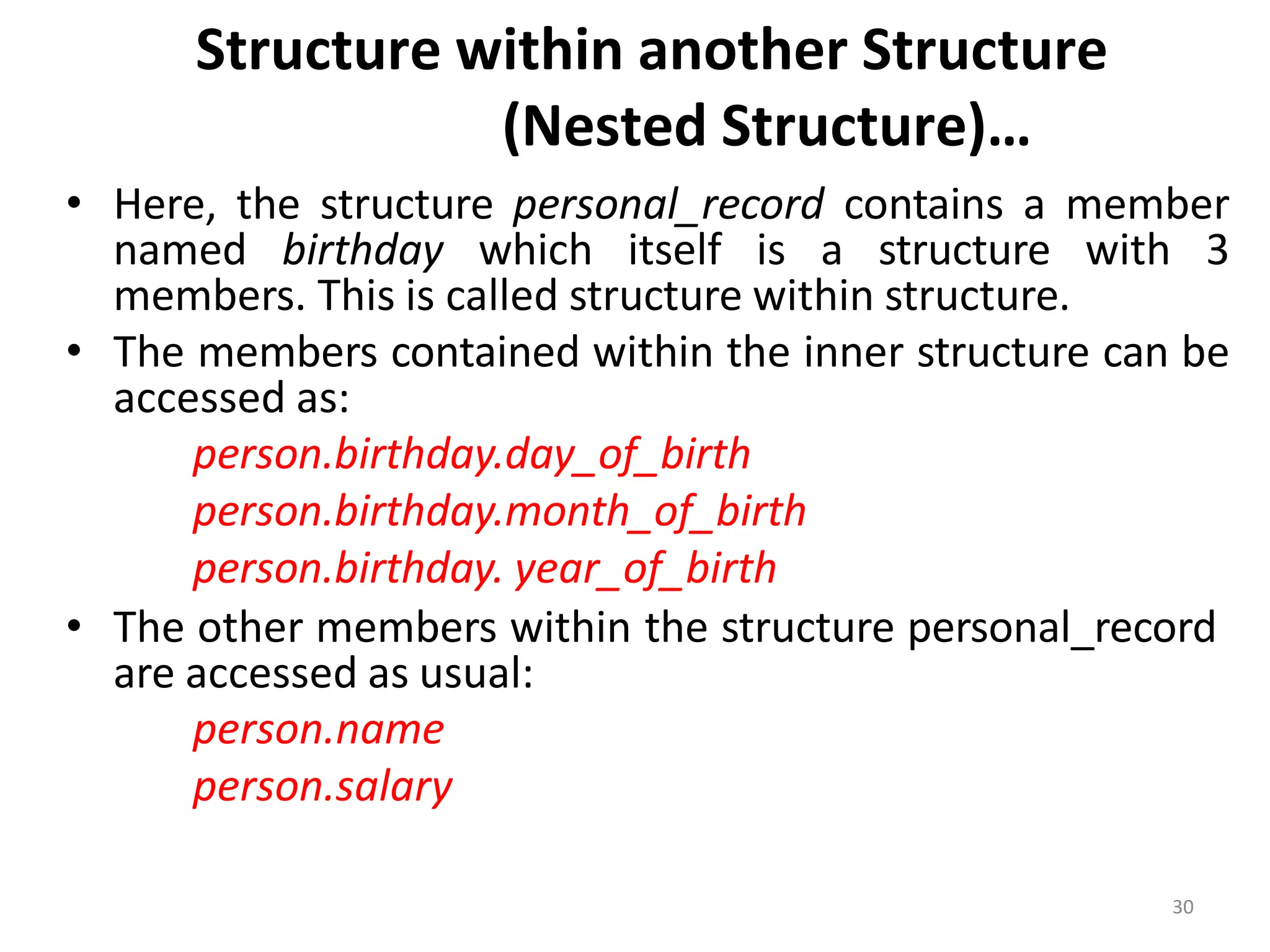
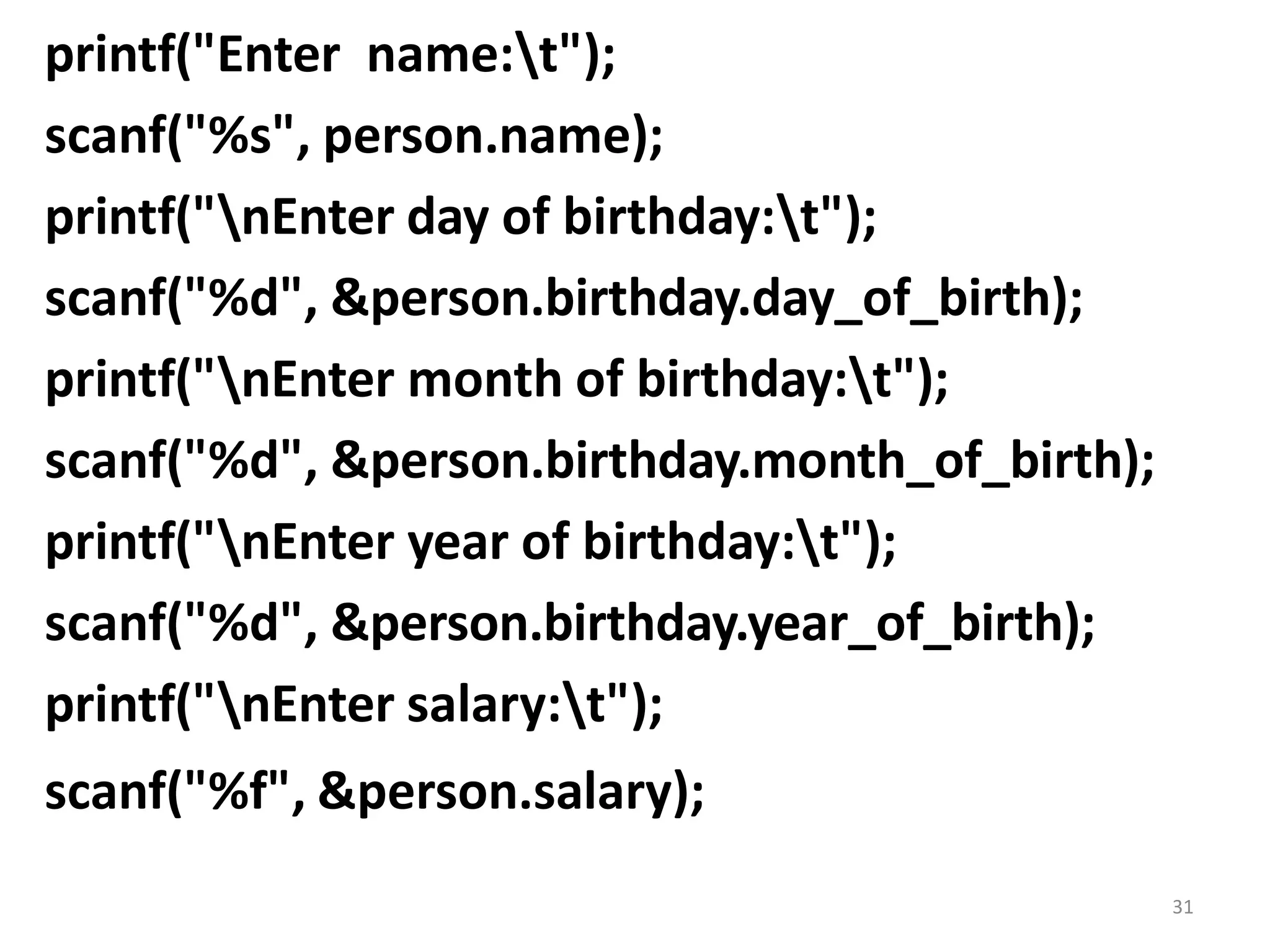
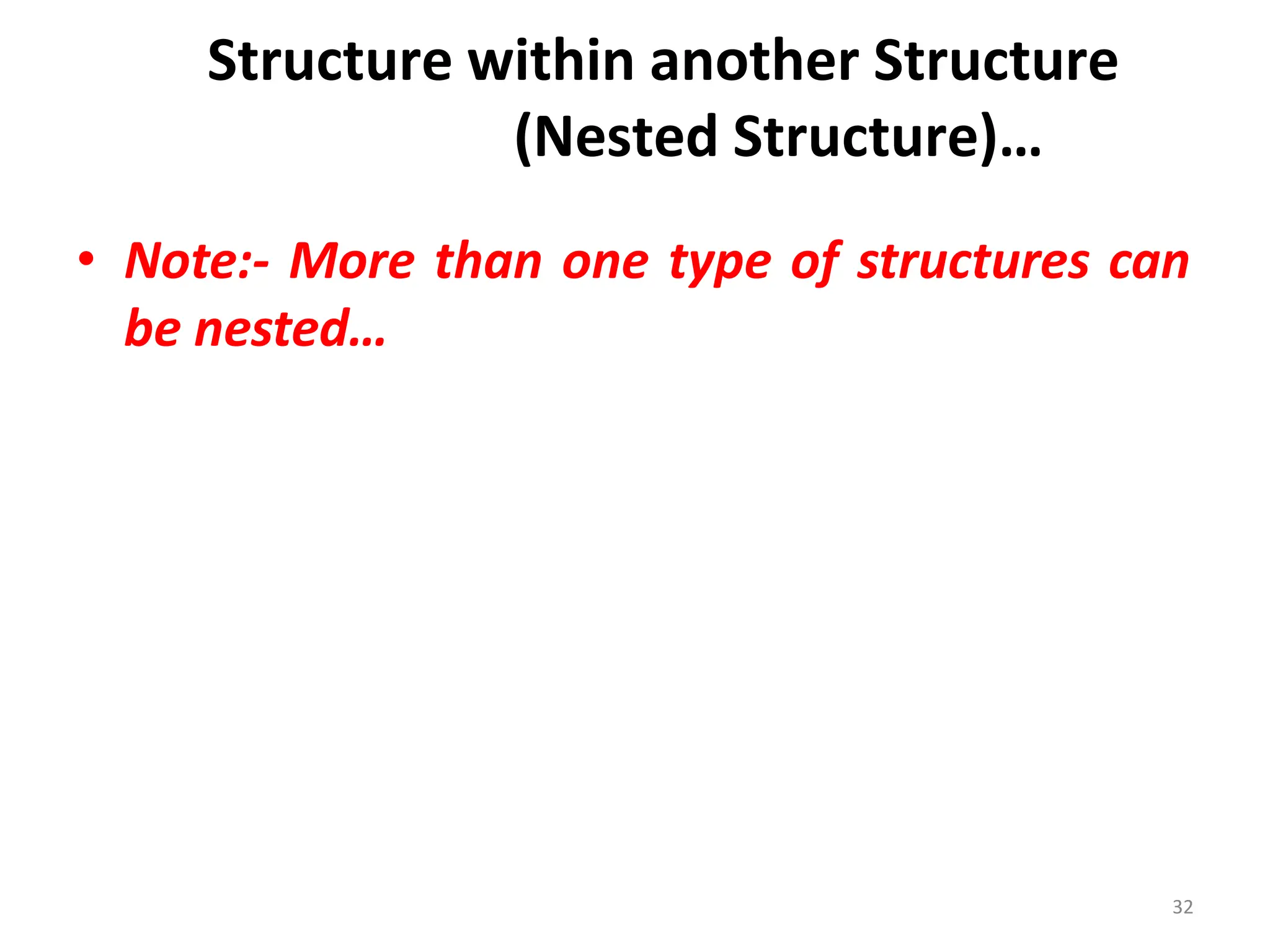
![33
struct date
{
int day;
int month;
int year;
};
struct name
{
char first_name[10];
char middle_name[10];
char last_name[10];
};
struct personal_record
{
float salary;
struct date birthday,deathday;
struct name full_name;
};](https://image.slidesharecdn.com/structureincprogram-240510123220-b6219d62/75/Fundamentals-of-Structure-in-C-Programming-33-2048.jpg)
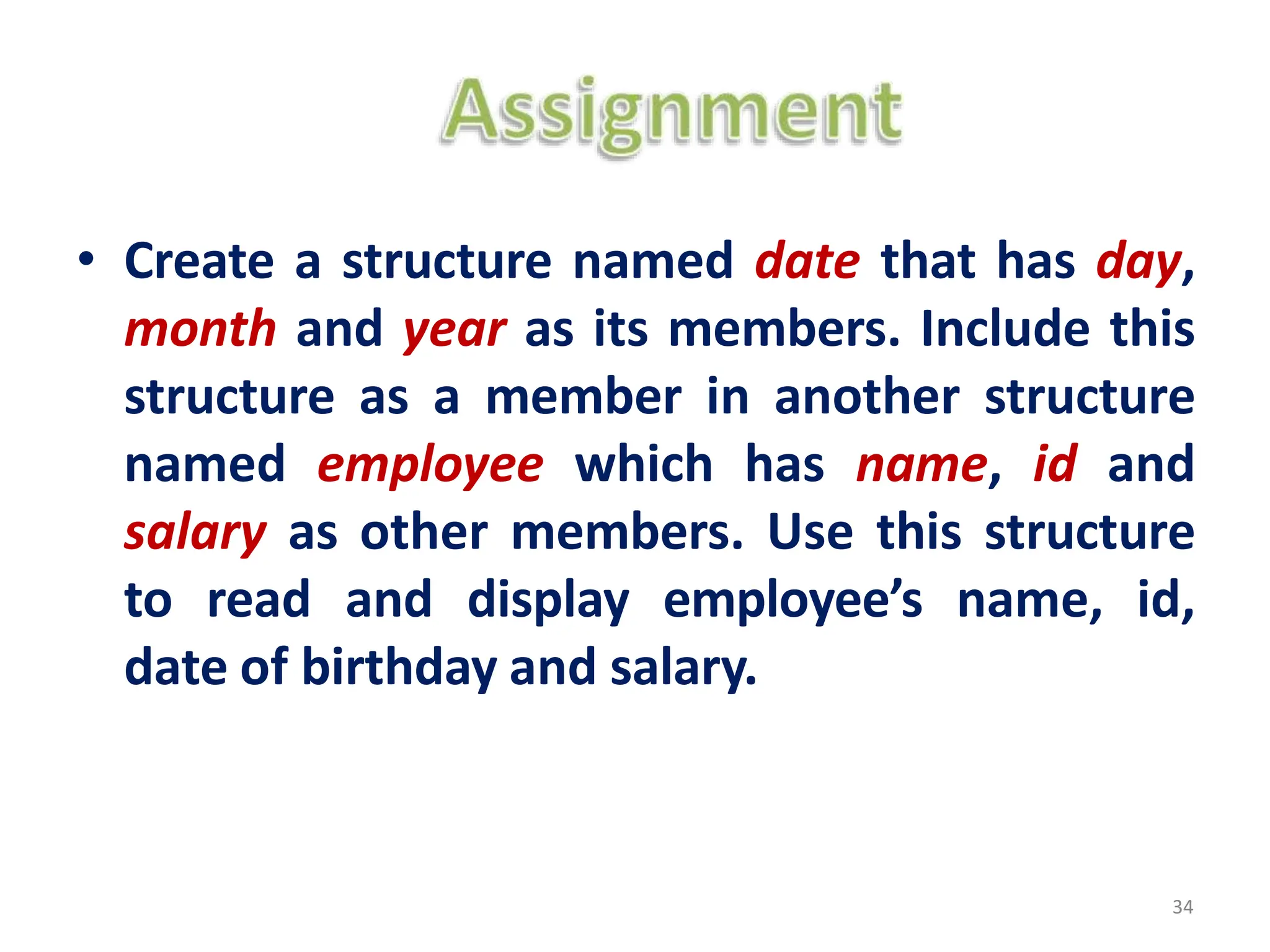
![Pointer to Structure
• A structure type pointer variable can be declared as:
struct book
{
char name[20];
int pages;
float price;
};
struct book *bptr;
• However, this declaration for a pointer to structure does not allocate any memory for a
structure but allocates only for a pointer, so that to access structure’s members
through pointer bptr, we must allocate the memory using malloc() function.
• Now, individual structure members are accessed as:
bptr->name bptr->pages bptr->price
(*bptr).name (*bptr).pages (*bptr).price
• Here, -> is called arrow operator and there must be a pointer to the structure on the
left side of this operator.
35](https://image.slidesharecdn.com/structureincprogram-240510123220-b6219d62/75/Fundamentals-of-Structure-in-C-Programming-35-2048.jpg)
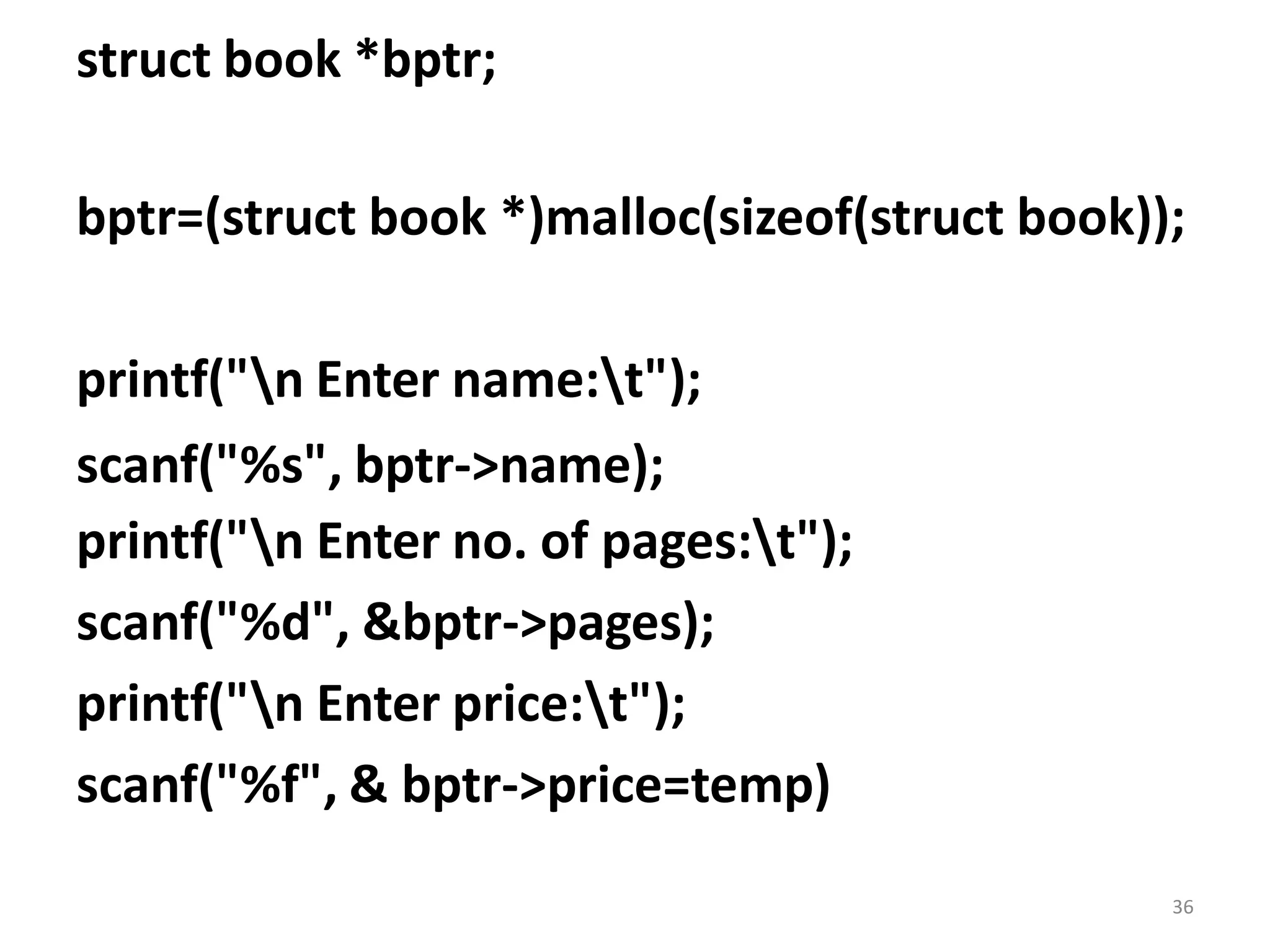
![37
Pointer to Structure…
• Also, the address of a structure type variable can be
stored in a structure type pointer variable as follows:
struct book
{
char name[20];
int pages;
float price;
};
struct book b, *bptr;
bptr=&b;
• Here, the base address of b is assigned to bptr pointer.](https://image.slidesharecdn.com/structureincprogram-240510123220-b6219d62/75/Fundamentals-of-Structure-in-C-Programming-37-2048.jpg)
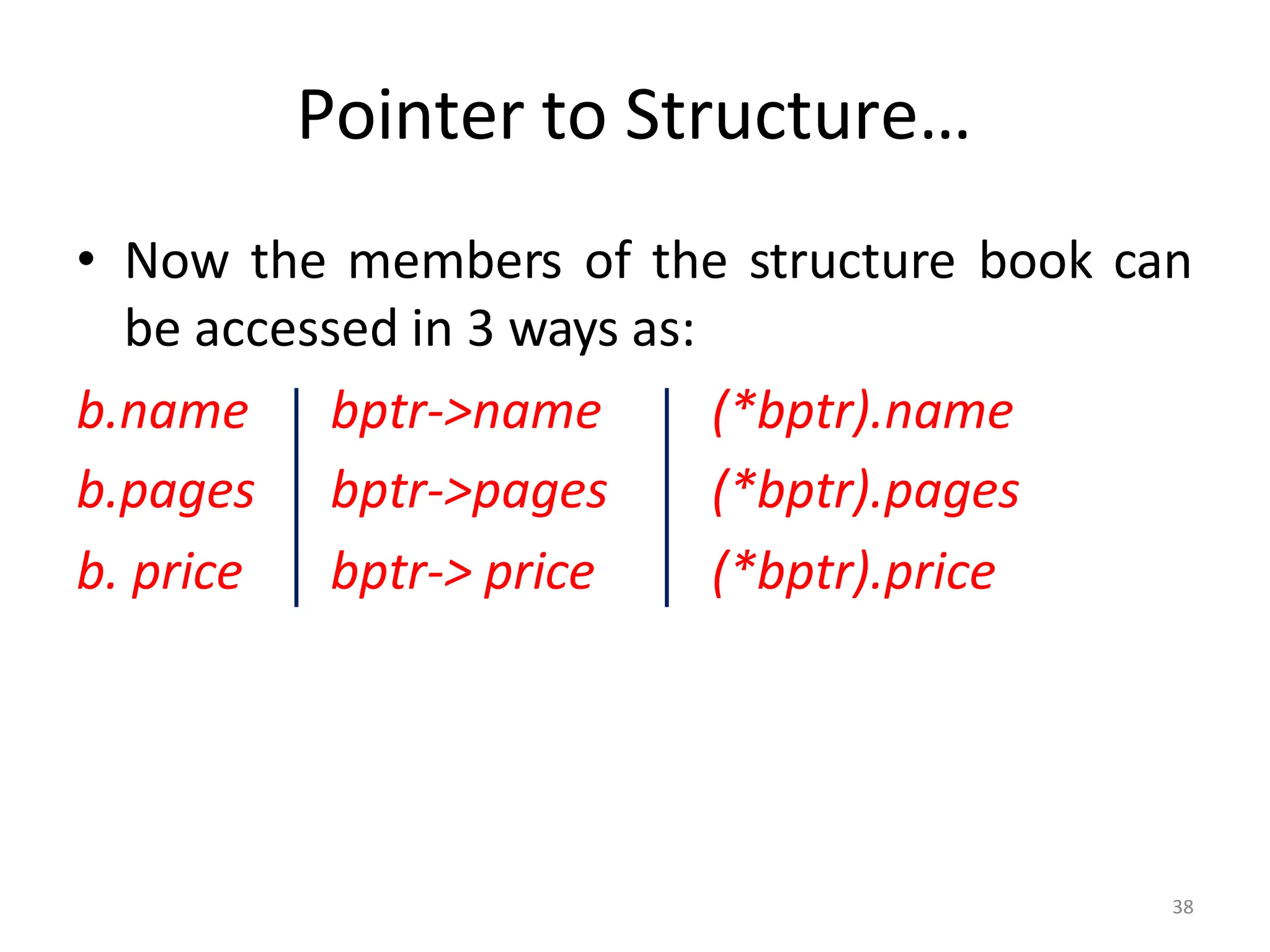
![39
Pointer to array of structure
• Let we have a structure as follows:
struct book
{
char name[20];
int pages;
float price;
};
struct book b[10], *bptr;
• Then the assignment statement bptr=b; assigns
the address of the zeroth element of b to bptr.](https://image.slidesharecdn.com/structureincprogram-240510123220-b6219d62/75/Fundamentals-of-Structure-in-C-Programming-39-2048.jpg)
![40
Pointer to array of structure…
• The members of b[0] can be accessed as:
bptr->name bptr->pages bptr->price
• Similarly members of b[1] can be accessed as:
(bptr+1)->name (bptr+1)->pages (bptr+1)->price
• The following for statement can be used to print
all the values of array of structure b as:
for(bptr=b;bptr<b+10;bptr++)
printf(“%s %d %f”, bptr->name, bptr->pages, bptr-
>price);](https://image.slidesharecdn.com/structureincprogram-240510123220-b6219d62/75/Fundamentals-of-Structure-in-C-Programming-40-2048.jpg)
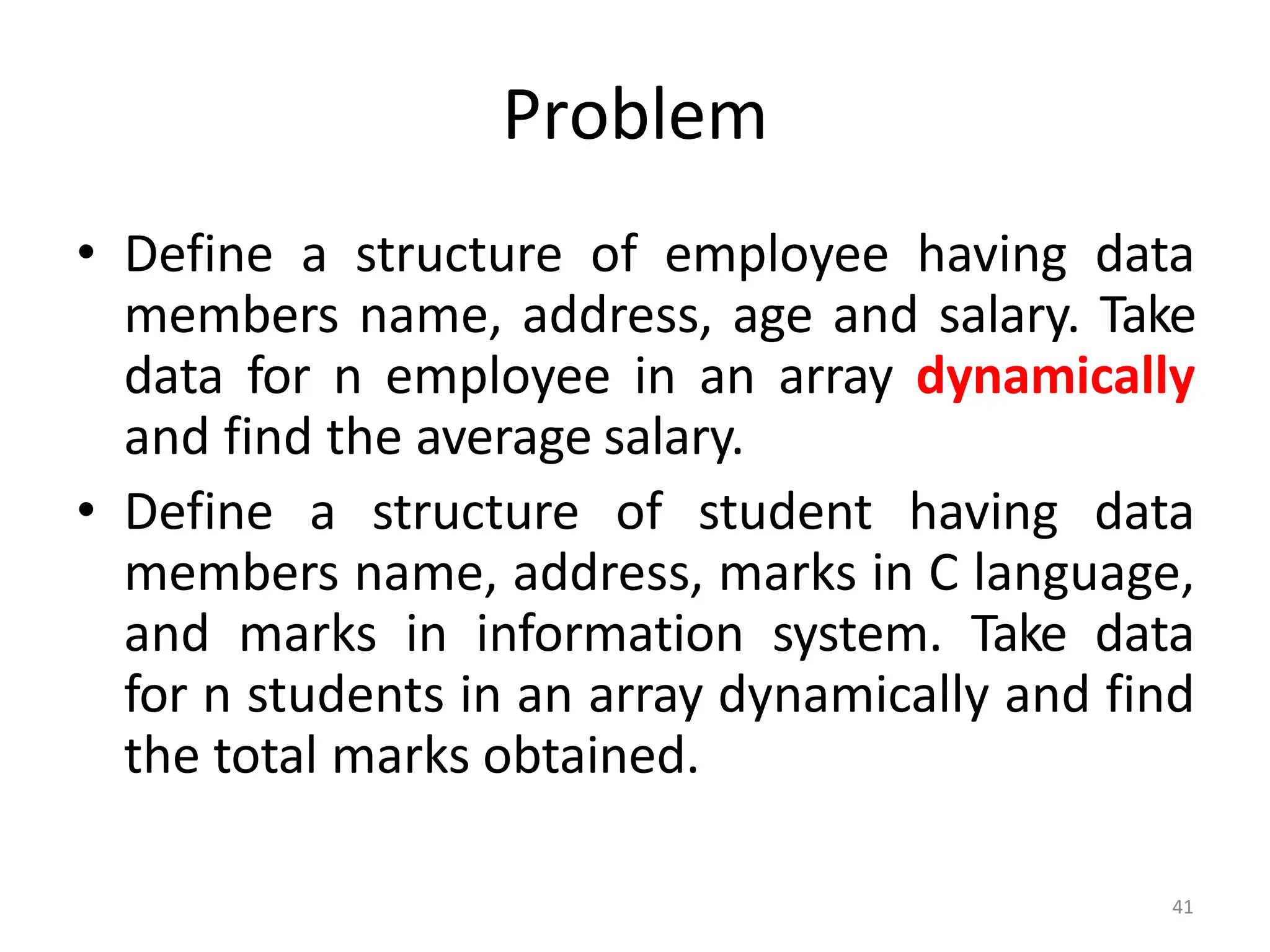
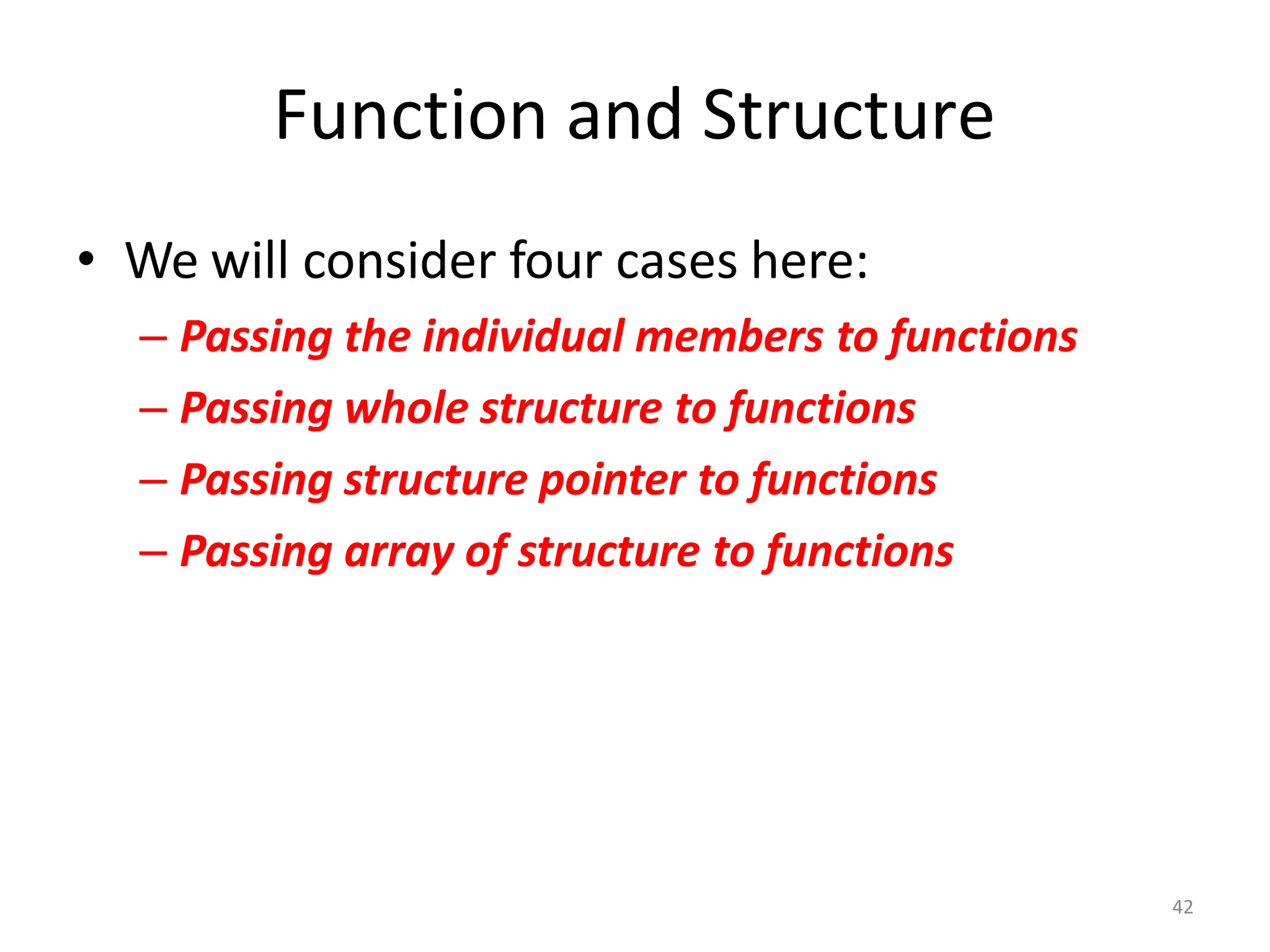
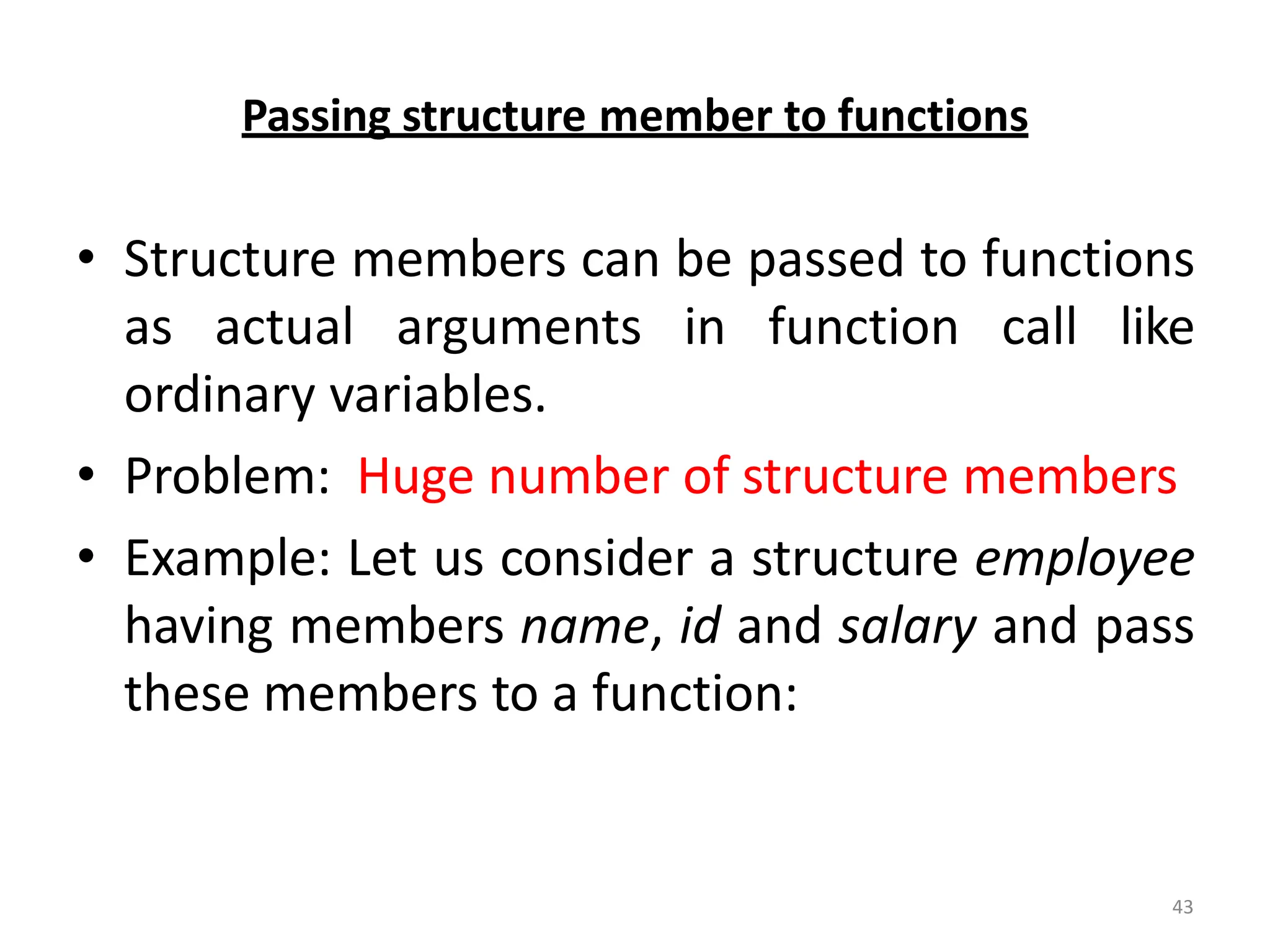
![display(emp.name,emp.id,emp.salary);
Void display(char e[],int id ,float sal )
{
printf("nNamettIDttSalaryn);
printf("%st%dt%.2f",e,id,sal);
}](https://image.slidesharecdn.com/structureincprogram-240510123220-b6219d62/75/Fundamentals-of-Structure-in-C-Programming-44-2048.jpg)
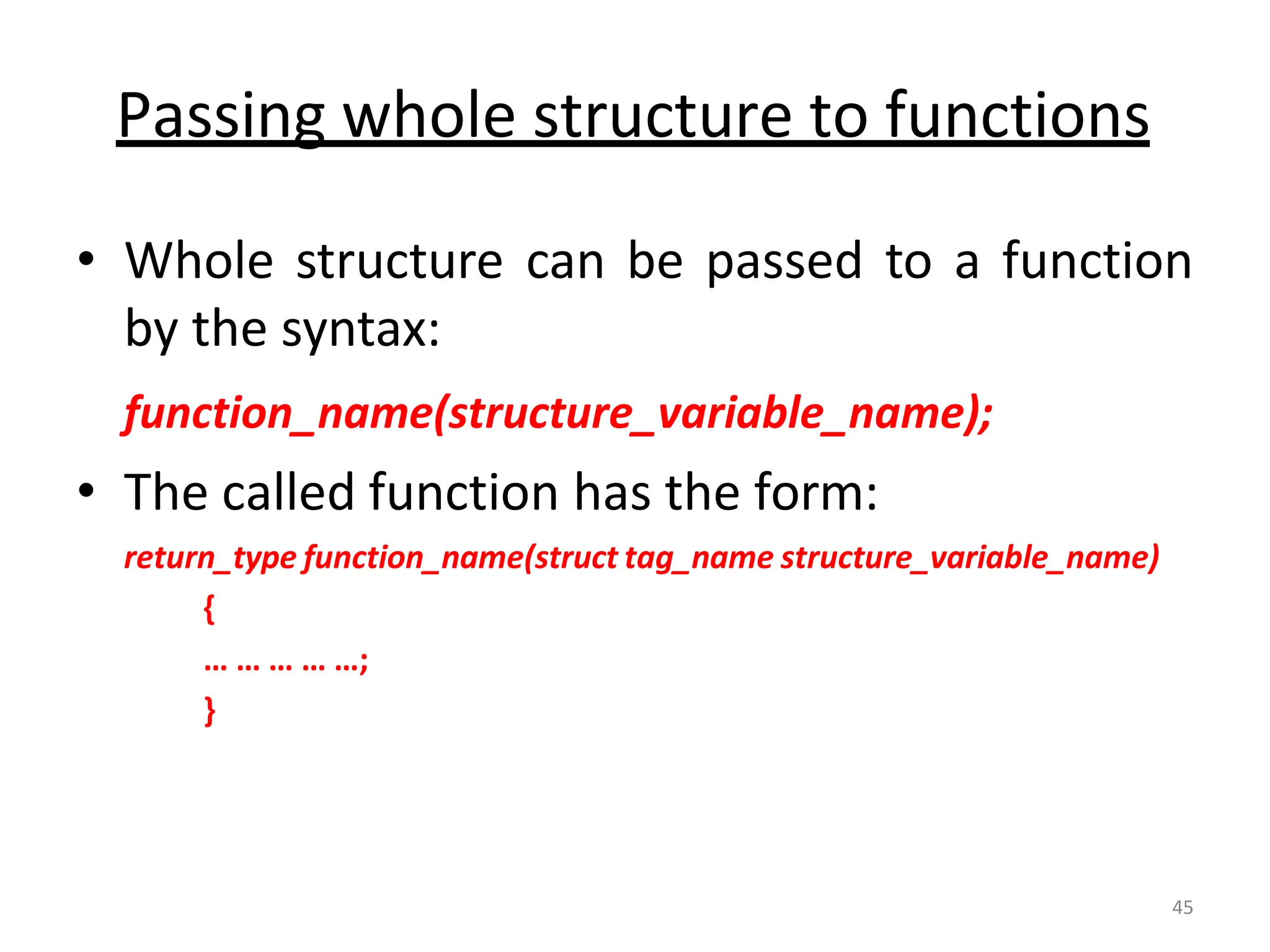

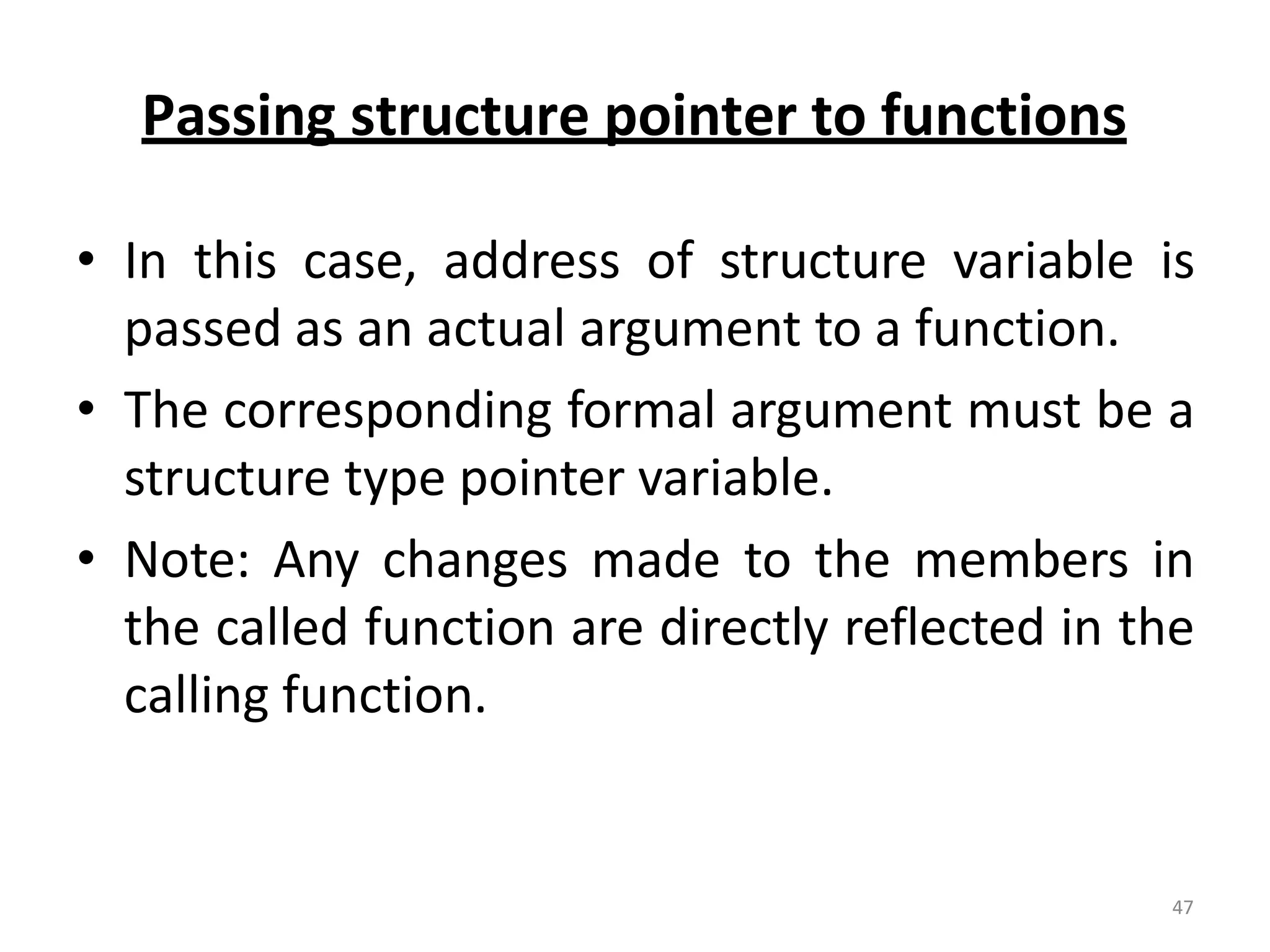

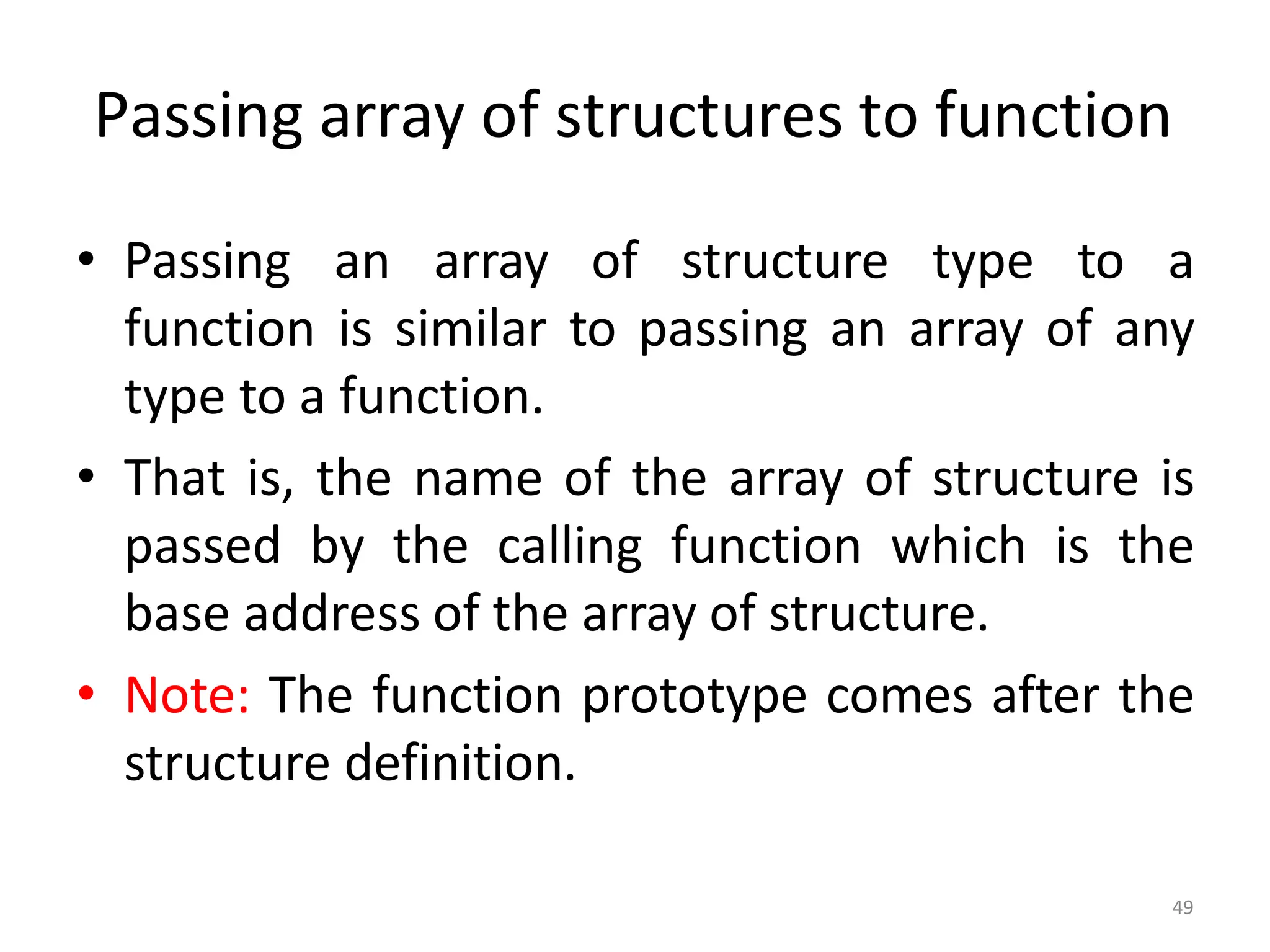
![display(emp); // emp is array name of size 2
void display(struct employee ee[])
{
int i;
printf("n Namett IDtt Salaryn");
for(i=0;i<2;i++)
{
printf("%stt%dtt%.2fn",ee[i].name,ee[i].id,ee[i].salary);
}
}](https://image.slidesharecdn.com/structureincprogram-240510123220-b6219d62/75/Fundamentals-of-Structure-in-C-Programming-50-2048.jpg)